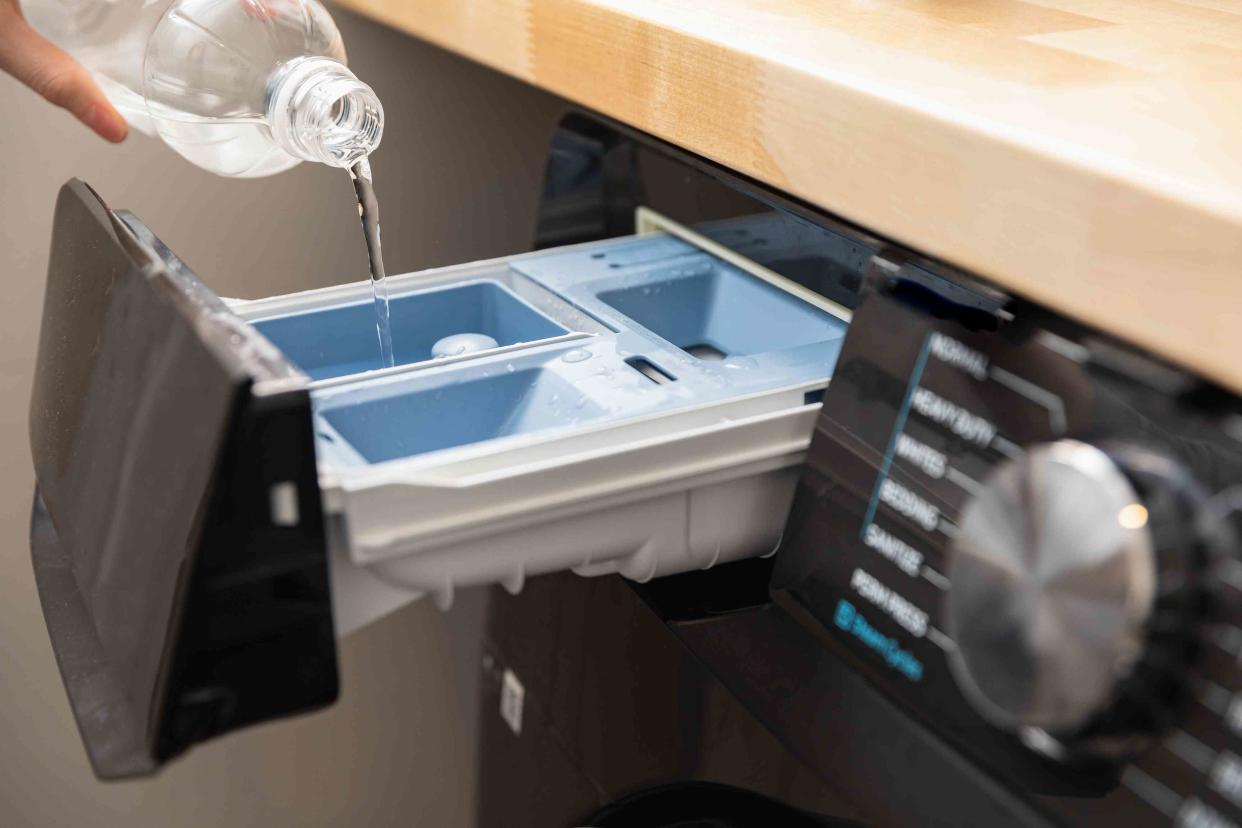How to Use Vinegar as a Cheap Alternative to Fabric Softener

The Spruce / Ana Cadena
Reviewed by Rhea Mehta
Distilled white vinegar is one of the most versatile and cost-effective cleaning products you can have in your cleaning supplies. It can be used for everything from unclogging drains to removing hard water stains from glass to cleaning luxury vinyl plank floors. But did you know that vinegar can also be used as a cheap alternative to fabric softener in the laundry room?
Learn the benefits of using vinegar to soften clothes and towels.
5 Reasons to Use Vinegar Instead of a Commercial Fabric Softener
Vinegar leaves clothes scent-free: While vinegar has a distinctive odor when added to the rinse cycle the scent is not transferred to your laundry. Most commercial fabric softeners have fragrances added that may not be pleasant to everyone.
Vinegar is more hypoallergenic: Distilled white vinegar contains no dyes that can irritate the skin. According to dermatologists, the dyes in detergents and fabric softeners are the main cause of skin irritation.
Vinegar is less expensive: Distilled white vinegar is inexpensive and can be used in numerous ways around the house. Each load of laundry requires around 1/2 cup. This will help you compare its cost versus the cost of a commercial fabric softener per load.
Vinegar is eco-friendly: Vinegar is non-toxic and biodegradable. It contains no petroleum-based chemicals.
Vinegar leaves your washer and dryer cleaner: Just as vinegar removes residue left in laundry, it also helps prevent and removes laundry product residue left in your washer and dryer. One of the leading causes of washer odor is mold feeding on the body soil and fabric softener residue left in the washer after each load. That same residue is transferred from your laundry fabric to the inside of the dryer and can interfere with electronic sensors.
How to Use Vinegar as a Fabric Softener
For an average-sized laundry load, 1/2 cup of vinegar should be added directly to the washer at the beginning of the rinse cycle. If your washer has an automatic fabric softener dispenser, fill it with vinegar before each load.
Tip
If you like your laundry to have a scent, you can make scented vinegar. Add a couple of drops of essential oil (lavender is a popular fragrance) or steep some herbs in the bottle of laundry vinegar.
Why is Vinegar an Effective Fabric Softener?
If your laundry routine is not handled correctly—you use too much detergent, loads are too large for the washer, or you practice excessive use of commercial fabric softeners—soil and product residue get left in the fibers. This leads to scratchy towels, trapped odors, and dingy colors.
Distilled white vinegar is a five percent solution of acetic acid that is strong enough to dissolve the alkaline soap and fabric softener residue that has built up on fibers but mild enough to prevent damage to the fabric. By removing the residue, the fabrics feel softer to the touch, and less lint and pet hair cling to clothes.
Additional Uses of Vinegar in the Laundry Room
Reduce Sweat Odors
Fill a spray bottle with undiluted distilled white vinegar and keep it on hand to remove perspiration odor and stains on washable clothing. Spray the vinegar directly on the inside of underarm areas and allow it to work for at least 10 minutes before tossing the garment into the washing machine. If the fabric feels stiff before washing, use a soft-bristle brush to break up the residue. The vinegar will cut through residual deodorant left on clothing and help prevent underarm yellowing.
Hide Hem Lines
To get rid of the tiny holes left along a seam or hemline when a garment is altered, moisten a white cloth with distilled white vinegar, place it over the fabric, and press with an iron. Be sure to select the correct ironing temperature to prevent scorching.
Reduce Sputtering and Remove Buildup from an Iron
Mineral deposits can clog an iron's steam vents and spray nozzles. To clean an iron and remove the deposits, fill the water chamber with a solution of equal parts distilled white vinegar and distilled water. Set the iron in an upright position on a heatproof surface, and let it steam for about five minutes.
When the iron is cool, rinse the tank with distilled water. Refill the iron and shake water through the vents onto an old cloth. Finally, iron an old cloth for several minutes to expel any residue before ironing wearable garments.
To remove scorch marks from the faceplate of an iron, rub with a paste of equal parts distilled white vinegar and salt. Finish by wiping down the faceplate with a cloth dampened with full-strength distilled white vinegar.
Read Next: What's in White Vinegar? - Plus 11 Ways to Use It
Read the original article on The Spruce.

